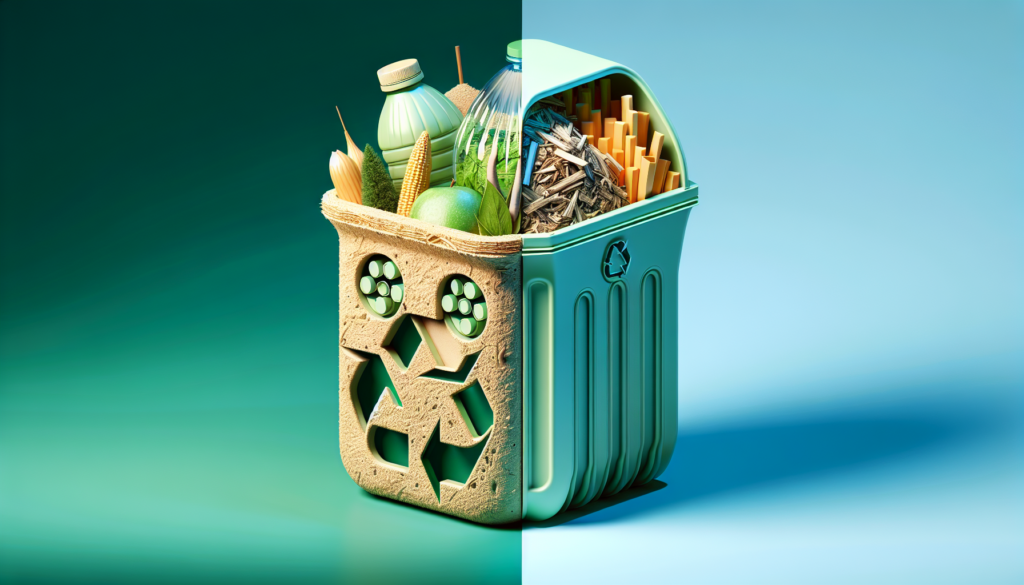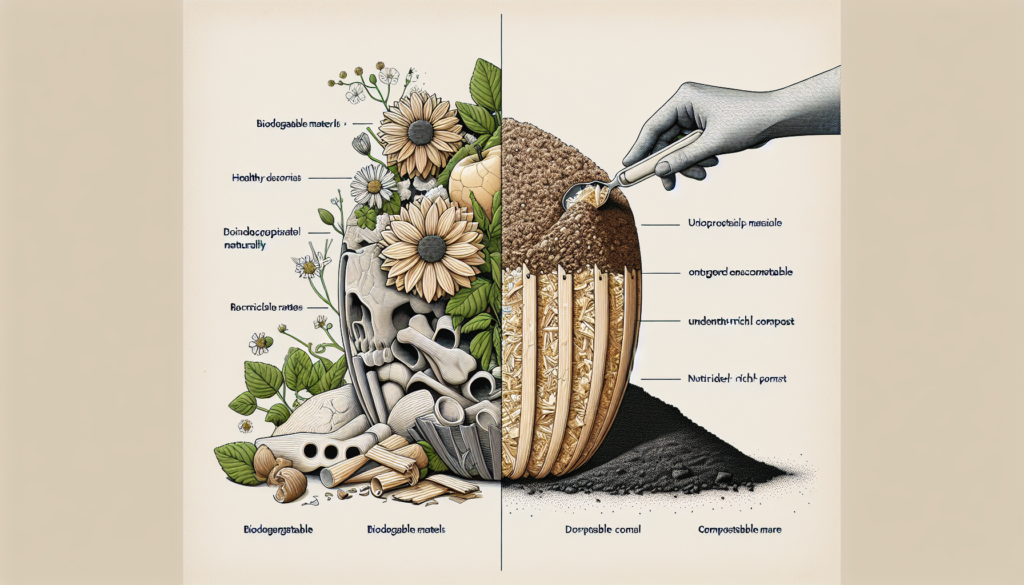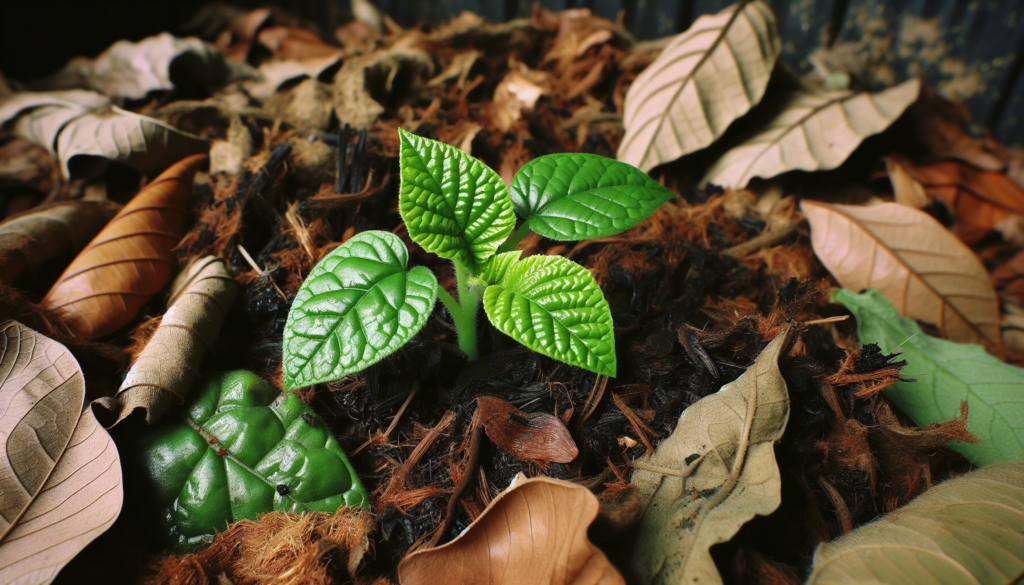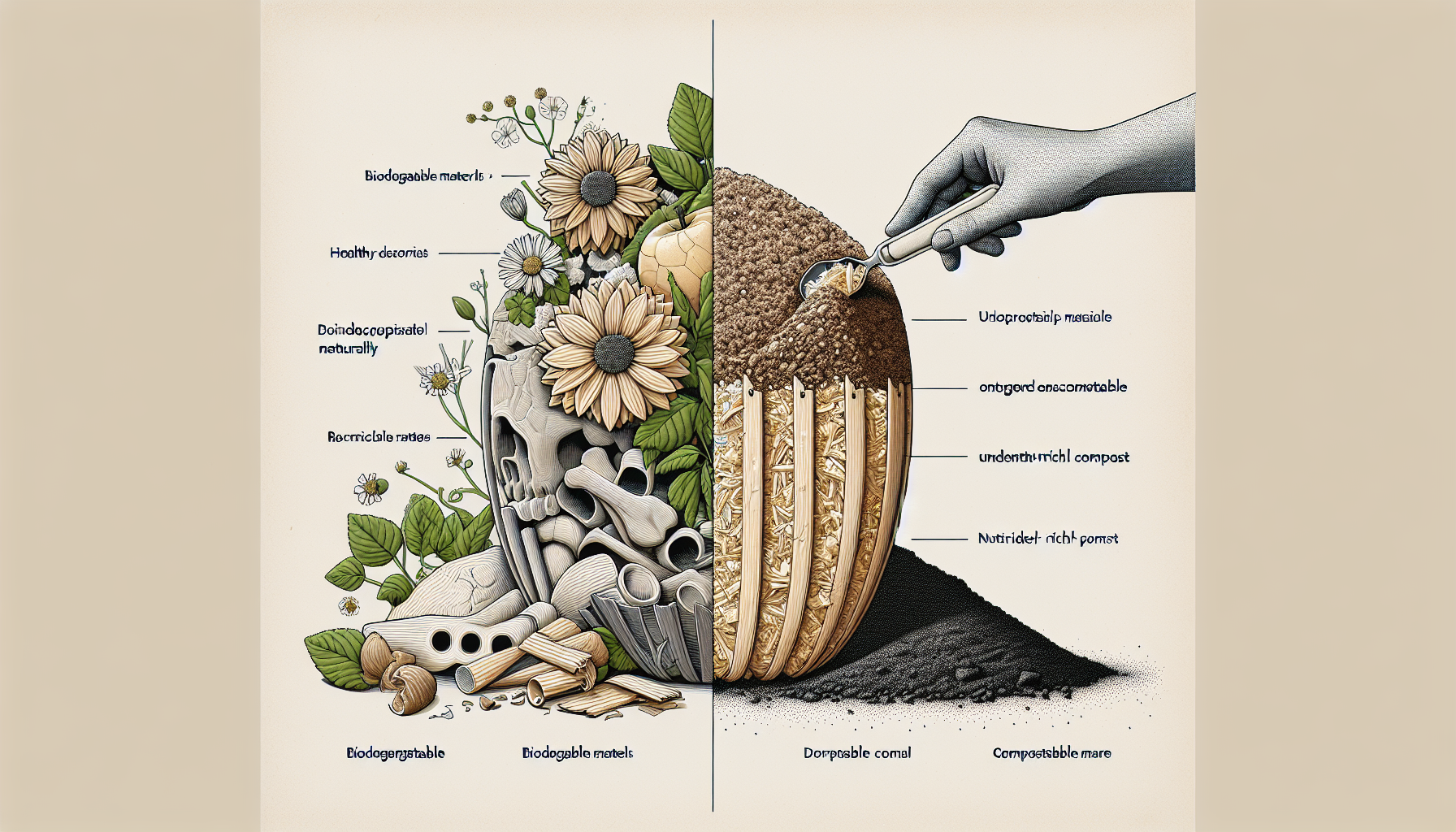Are you confused about the difference between biodegradable and compostable materials? In this article, we will clear up the confusion and provide a simple explanation of these two terms. Understanding the distinction between biodegradable and compostable materials is essential for making sustainable choices, so let’s dive right in and learn more about these eco-friendly options.
What are Biodegradable Materials?
Definition of Biodegradable Materials
Biodegradable materials are substances that can break down completely and naturally into their constituent elements when exposed to the environment, typically through the action of microorganisms such as bacteria or fungi. This decomposition process occurs over time, returning the materials back to the earth and reducing their impact on the environment. Unlike non-biodegradable materials, which may persist in the environment for many years, biodegradable materials offer a more sustainable alternative.
Examples of Biodegradable Materials
There are numerous examples of biodegradable materials in both natural and synthetic forms. Organic materials such as food waste, leaves, and wood are biodegradable and can be easily processed by organisms in the environment. Some synthetic biodegradable materials include certain types of plastics, such as PLA (polylactic acid), as well as biodegradable packaging materials like paper and cardboard. These materials offer opportunities for more responsible waste management practices.
Benefits of Biodegradable Materials
Biodegradable materials offer several benefits over traditional non-biodegradable materials. Firstly, they contribute to the reduction of waste accumulation in landfills, as they can degrade and return to the earth naturally. This helps to alleviate the strain on limited landfill space, which can be a significant environmental concern. Additionally, biodegradable materials have the potential to reduce the release of harmful chemicals and greenhouse gases during decomposition, further mitigating their impact on the environment. Moreover, using biodegradable materials can promote a shift towards more sustainable and conscious consumption practices.
Limitations of Biodegradable Materials
While biodegradable materials offer numerous advantages, it is important to consider their limitations. One significant limitation is the timeframe required for complete decomposition. Some biodegradable materials may require specific conditions, such as optimal temperature and moisture levels, to degrade at a reasonable pace. In certain environments, decomposition may be slower than expected, leading to longer-term environmental impacts. Furthermore, the production of biodegradable materials may still require significant amounts of resources and energy, leading to potential environmental trade-offs. Careful consideration of these limitations is crucial for developing and adopting sustainable waste management practices.
What are Compostable Materials?
Definition of Compostable Materials
Compostable materials are a subset of biodegradable materials that can undergo a specific composting process, resulting in the formation of nutrient-rich compost. Composting is a controlled, natural decomposition process that transforms organic materials into a valuable soil amendment called compost. Compostable materials, when properly composted, break down into organic matter that enriches the soil, providing essential nutrients for plant growth. These materials are designed to degrade completely and without leaving any harmful residues, offering an eco-friendly alternative for waste management.
Examples of Compostable Materials
Several materials fall under the category of compostable, including both organic and synthetic materials. Organic compostable materials consist of food scraps, yard trimmings, and other plant-based wastes. These materials can provide valuable nutrients to the composting process and contribute to the creation of nutrient-rich soil. Synthetic compostable materials, such as certified compostable plastics, are specifically designed to break down in composting facilities, eliminating the need for sorting and separation during waste processing. These materials offer potential solutions for reducing plastic waste.
Benefits of Compostable Materials
Compostable materials offer a range of benefits, including the production of high-quality compost that can enrich soil and promote sustainable agriculture. By diverting organic waste from landfills, compostable materials contribute to the reduction of greenhouse gas emissions. Additionally, the use of compostable materials can help minimize contamination in recycling streams, ensuring a higher rate of recyclability for other materials. Compostable packaging materials can also provide an alternative to traditional single-use plastics, contributing to a cleaner environment and reducing the consumption of finite resources.
Limitations of Compostable Materials
While compostable materials have their advantages, they also face limitations. The most significant limitation is the requirement for specific composting conditions to achieve proper decomposition. Composting facilities must maintain optimal temperatures, moisture levels, and proper aeration for efficient breakdown. If compostable materials are disposed of improperly, such as in regular landfills or mixed with non-compostable materials, they may not decompose as intended and may contribute to environmental pollution. Furthermore, compostable materials may have specific limitations in terms of shelf life and durability, which can affect their application in certain industries.

Differences between Biodegradable and Compostable Materials
Degradation Process
While both biodegradable and compostable materials break down naturally, the degradation process differs. Biodegradable materials degrade through the action of microorganisms over time, returning to the environment as their constituent elements. Compostable materials, on the other hand, require specific composting conditions to degrade into nutrient-rich compost. The composting process involves a combination of heat, moisture, and aeration, allowing microorganisms to break down the materials more rapidly.
Timeframe for Decomposition
Another difference between biodegradable and compostable materials is the timeframe required for decomposition. Biodegradable materials can take varying amounts of time to degrade, depending on factors such as the material composition, environmental conditions, and the presence of microorganisms. Compostable materials, when properly managed in a composting facility, typically decompose within a specific timeframe, usually within three to six months. This accelerated degradation process is crucial in the production of compost.
Environmental Impact
Both biodegradable and compostable materials have the potential to reduce environmental impacts compared to non-biodegradable materials. Biodegradable materials can help reduce waste accumulation in landfills, mitigating the release of harmful chemicals and greenhouse gases. Compostable materials, in addition to waste reduction, promote the production of nutrient-rich compost that can improve soil health and reduce the need for synthetic fertilizers. The proper management of compostable materials can result in environmental benefits throughout the entire lifecycle of the product.
Certification and Standards
Certification and standards play a vital role in distinguishing biodegradable and compostable materials. Various certification bodies and standards, such as the Biodegradable Products Institute (BPI) and the European Norm (EN) 13432, provide guidelines and criteria for verifying the biodegradability and compostability of materials. These certifications ensure that materials meet specific requirements for effective degradation or composting. Thus, certification helps consumers and businesses make informed choices and encourages the adoption of environmentally responsible materials.
Understanding Biodegradable Materials
Natural Biodegradation Process
Natural biodegradation is the process by which microorganisms convert complex organic materials into simpler compounds, such as water, carbon dioxide, and biomass. This process occurs naturally in the environment, as microorganisms break down organic matter to obtain energy and nutrients. Factors such as temperature, moisture, oxygen availability, and microbial activity influence the rate and efficiency of biodegradation. Biodegradable materials leverage this natural process to minimize their environmental impact and create a more sustainable future.
Biodegradable Plastics
Biodegradable plastics are a specific category of biodegradable materials that offer an alternative to traditional non-biodegradable plastics. These plastics are engineered to break down through microbial action, ultimately decomposing into harmless substances. They can be made from various sources such as plant starch, PLA, or PHA (polyhydroxyalkanoates). Biodegradable plastics are increasingly used in packaging, disposable cutlery, food containers, and other applications, providing a more sustainable option compared to conventional plastics.
Biodegradable Packaging
Biodegradable packaging refers to packaging materials that are designed to break down naturally and return to the environment. These materials can include bioplastics, paper, cardboard, and certain types of films and coatings. Biodegradable packaging offers the advantages of reduced waste accumulation and decreased reliance on non-renewable resources. It can be used in various sectors, such as food and beverage, pharmaceuticals, and personal care, to reduce the environmental impact of packaging waste.
Common Uses of Biodegradable Materials
Biodegradable materials find applications in various industries, contributing to sustainable practices and waste reduction. In the agricultural sector, biodegradable mulch films provide a more environmentally friendly solution compared to traditional plastic films. Biodegradable food packaging materials help reduce the environmental footprint of the food industry. Biodegradable sanitary products, such as diapers and wipes, offer a more sustainable alternative, reducing landfill waste. These examples highlight the versatility and potential of biodegradable materials in addressing environmental challenges.

Understanding Compostable Materials
Composting Process
Composting is a natural biological process that transforms organic materials into nutrient-rich compost. The process involves the collection and controlled decomposition of organic waste material, such as food scraps, leaves, and yard trimmings. Composting requires specific conditions, including temperature, moisture, aeration, and carbon-to-nitrogen ratios, to facilitate the breakdown of organic matter. Over time, microorganisms break down the organic materials, resulting in a dark, crumbly, and nutrient-dense compost that can enhance soil fertility.
Compostable Plastics
Compostable plastics are a subset of compostable materials specifically designed to break down in composting facilities. These plastics, often made from renewable resources like corn starch or sugar cane, undergo a specific composting process where they biodegrade into organic matter and do not leave behind any harmful residues. Compostable plastics can be used for a variety of applications, including disposable cutlery, food packaging, and single-use bags, providing an environmentally friendly alternative to traditional plastics.
Compostable Packaging
Compostable packaging refers to packaging materials that are designed to be composted along with organic waste. These materials, such as bio-based films, coatings, and containers, are designed to break down in composting facilities, leaving behind nutrient-rich compost that can be used in agriculture and landscaping. Compostable packaging can help reduce the environmental impact of packaging waste and promote the circular economy by closing the loop in waste management.
Applications of Compostable Materials
Compostable materials have a wide range of applications in various industries. In the food service industry, compostable plates, cups, and utensils offer an eco-friendly alternative to traditional plastic products. Compostable bags and films can be used for packaging fresh produce, reducing the need for single-use plastics. Compostable agricultural mulch films can contribute to soil health and reduce the environmental impact of conventional plastic films. These applications demonstrate the versatility of compostable materials in addressing waste management challenges.
Comparison of Environmental Impact
Carbon Footprint
Biodegradable and compostable materials have the potential to reduce carbon emissions compared to traditional non-biodegradable materials. The production of biodegradable and compostable materials often utilizes renewable resources, such as plant-based feedstock, which have lower carbon emissions compared to fossil-fuel-derived materials. Additionally, the decomposition of biodegradable and compostable materials can release fewer greenhouse gases, as the natural degradation process does not involve the combustion of carbon compounds.
Toxicity
Non-biodegradable materials, especially certain types of plastics, can release toxic substances as they degrade or are exposed to environmental conditions. Biodegradable and compostable materials, on the other hand, are designed to break down into harmless substances that do not leach into the environment. This reduced toxicity potential minimizes the risk of soil, water, and air pollution, contributing to a healthier ecosystem.
Soil Enrichment
Compostable materials, when managed properly through composting, can enrich the soil by providing essential nutrients. The resulting compost acts as a natural fertilizer, improving soil structure and fertility. Biodegradable materials, while they may contribute to soil enrichment over time as they break down, may not provide the same level of nutrient content as compostable materials. The ability of compostable materials to directly enhance soil health adds to their environmental value.
Landfill Impact
One of the significant advantages of biodegradable and compostable materials is their potential to reduce waste accumulation in landfills. Non-biodegradable materials, including certain plastics, may take centuries or more to decompose in landfills, contributing to the accumulation of waste. Biodegradable and compostable materials, when properly managed, can break down more readily, reducing the strain on landfill capacity and minimizing the long-term environmental impact associated with landfills.

Importance of Certification and Standards
Certification Bodies
Certification bodies play a crucial role in verifying the biodegradability and compostability of materials. Organizations such as the Biodegradable Products Institute (BPI), the American Society for Testing and Materials (ASTM), and the European Norm (EN) provide certifications and guidelines for manufacturers, ensuring their products meet specific criteria for biodegradability and compostability. These certifications help consumers and businesses make informed decisions about the environmental attributes of materials and promote the adoption of sustainable alternatives.
Compostable Standards
Standards for compostability outline specific criteria for materials to be considered compostable. Among the most recognized standards is EN 13432, which sets requirements for packaging recoverable through composting and biodegradation. This standard specifies degradation requirements, including timeframes, material composition, and environmental impacts. By complying with compostable standards, manufacturers can contribute to a more consistent and reliable composting process.
Biodegradable Standards
Biodegradable standards focus on defining the degree and rate of biodegradability. They emphasize the specific conditions under which materials degrade and the resulting impact on the environment. Standards such as ASTM D6400 provide guidelines for testing the biodegradability of plastics in various environments. Compliance with these standards ensures that biodegradable materials meet specific criteria, providing reassurance to consumers and avoiding instances of greenwashing.
Consumer Information and Labeling
Certification and standards also help in consumer education and awareness. Products that meet compostability or biodegradability standards often carry labels or certifications to inform consumers about the product’s environmental attributes. The presence of such labels helps consumers differentiate between genuinely compostable or biodegradable products and ones that may not meet the necessary criteria. Clear consumer information and labeling are essential to encourage responsible purchasing choices and promote the adoption of environmentally friendly materials.
Challenges and Limitations
Processing Challenges
One of the primary challenges associated with biodegradable and compostable materials is the need for proper waste management infrastructure. Biodegradable materials often require specific conditions and processes to degrade efficiently. Compostable materials, similarly, require appropriate composting facilities that can handle the materials effectively. The lack of suitable facilities and waste management systems can limit the widespread adoption and effective disposal of these materials, hindering their potential environmental benefits.
Commercial Availability
Despite advancements in technology and increased awareness of environmental concerns, biodegradable and compostable materials may not be readily available for all applications. Commercial availability can be limited, and certain industries may face challenges in finding suitable alternatives to non-biodegradable materials. For example, some highly specific or specialized products may not have viable biodegradable or compostable alternatives. Overcoming commercial availability challenges requires investment in research and development, as well as demanding sustainable alternatives from manufacturers and suppliers.
End-of-Life Management
Proper end-of-life management is crucial for maximizing the potential environmental benefits of biodegradable and compostable materials. If these materials are not disposed of or processed correctly, they can still contribute to waste accumulation and environmental pollution. Inadequate waste management practices, such as improper sorting or mixing of compostable and non-compostable materials, can hinder the composting process and result in contamination. Education and infrastructure development are necessary to ensure the proper end-of-life management of biodegradable and compostable materials.
Public Awareness and Education
Public awareness and education play a vital role in maximizing the benefits of biodegradable and compostable materials. Many consumers may not be aware of the differences between biodegradable and compostable materials or the proper disposal methods required. Lack of awareness can lead to improper waste disposal practices, negating the potential environmental benefits of these materials. Education campaigns, informative labeling, and accessible recycling and composting facilities can help bridge this awareness gap and empower individuals to make sustainable choices.

Future Developments and Innovations
New Biodegradable Materials
Ongoing research and development efforts continue to explore and develop new biodegradable materials with improved properties and enhanced environmental benefits. Scientists are investigating alternative feedstocks, innovative production techniques, and improved materials to expand the range of biodegradable options. For example, algae-based bioplastics and synthetic materials that mimic natural biodegradability are emerging as potential alternatives. These advancements have the potential to revolutionize the field, providing more sustainable alternatives for various applications.
Technological Advancements
Technological advancements also contribute to the evolution and growth of biodegradable and compostable materials. Improved composting technologies and facilities can handle a broader range of biodegradable and compostable materials, expanding their applicability. Additionally, advancements in material science and manufacturing processes can lead to more efficient and cost-effective production of biodegradable materials, promoting scalability and market availability.
Circular Economy Initiatives
The concept of the circular economy, which aims to minimize waste and maximize resource efficiency, presents significant opportunities for biodegradable and compostable materials. By adopting circular economy principles, businesses and industries can integrate biodegradable and compostable materials into closed-loop systems, reducing the reliance on finite resources and minimizing waste generation. Circular economy initiatives emphasize the importance of designs that enable reuse, recycling, and composting, supporting a sustainable transition.
Conclusion
Biodegradable and compostable materials offer valuable alternatives to traditional non-biodegradable materials, showcasing the potential to reduce waste accumulation and mitigate environmental impacts. Biodegradable materials undergo natural degradation over time, while compostable materials specifically require composting processes to transform into nutrient-rich compost. Both have their own set of advantages and limitations, contributing to different aspects of waste management and environmental sustainability.
Understanding the differences between biodegradable and compostable materials helps guide individuals and businesses in making more informed choices regarding waste disposal and the use of environmentally responsible materials. Certification and standards play a crucial role in verifying the attributes of these materials, ensuring their compliance with specific biodegradability or compostability requirements.
Challenges associated with biodegradable and compostable materials, including waste management infrastructure, commercial availability, end-of-life management, and public awareness, highlight the need for continued efforts in developing sustainable waste management practices and educating consumers.
With ongoing advancements in materials science, technology, and the embrace of circular economy principles, biodegradable and compostable materials hold promise for a more sustainable future. Through further innovation, investment, and collaboration, these materials can contribute to waste reduction, soil enrichment, and reduced environmental impact, fostering a more responsible and eco-friendly approach to consumption and waste management.

